
Pieter Bruegelthe Elder was the most significant artist of Dutch and Flemish Renaissance painting, a painter and printmaker, known for his landscapes and peasant scenes ; he was a pioneer in making both types of subject the focus in large paintings.
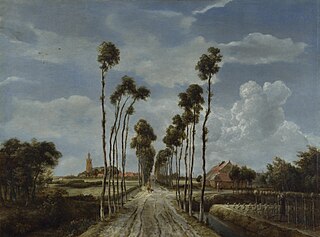
Meindert Lubbertszoon Hobbema was a Dutch Golden Age painter of landscapes, specializing in views of woodland, although his most famous painting, The Avenue at Middelharnis, shows a different type of scene.

Nicolaes Pieterszoon Berchem was a highly esteemed and prolific Dutch Golden Age painter of pastoral landscapes, populated with mythological or biblical figures, but also of a number of allegories and genre pieces.

Aert van der Neer, or Aernout or Artus, was a landscape painter of the Dutch Golden Age, specializing in small night scenes lit only by moonlight and fires, and snowy winter landscapes, both often looking down a canal or river. He was a contemporary of Aelbert Cuyp and Meindert Hobbema, and like the latter he lived and died in comparative obscurity.

Adriaen van de Velde, was a Dutch painter, draughtsman and print artist. His favorite subjects were landscapes with animals and genre scenes. He also painted beaches, dunes, forests, winter scenes, portraits in landscapes, as well as mythological and biblical scenes. He belongs to a group of painters referred to as the Dutch Italianate painters, who combined Dutch agricultural landscapes with mythological or Arcadian scenes in Italian settings. His paintings are characterised by their delicate, careful composition and his mastery of lighting effects as well as the human figure.

Barend Cornelis Koekkoek was a Dutch landscape artist and lithographer.

Hans Bol or Jan Bol, was a Flemish painter, miniature painter, print artist and draftsman. He is known for his landscapes, allegorical and biblical scenes, and genre paintings executed in a late Northern Mannerist style.

Lucas van Valckenborch or Lucas van Valckenborch the Elder was a Flemish painter, mainly known for his landscapes. He also made contributions to portrait painting, and allegorical and market scenes. Court painter to Archduke Matthias, the governor of the Spanish Netherlands in Brussels, he later migrated to Austria and then Germany where he joined members of his extended family of artists who had moved there for religious reasons.
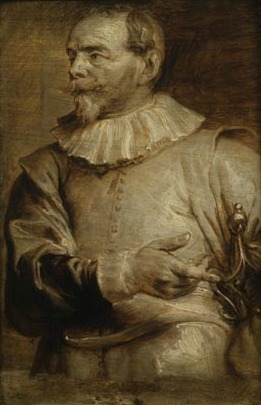
Sebastiaen Vrancx, Sebastiaan Vrancx or Sebastian Vranckx was a Flemish Baroque painter, draughtsman and designer of prints who is mainly known for his battle scenes, a genre that he pioneered in Netherlandish painting. He also created landscapes with mythological and allegorical scenes, scenes with robbers, village scenes and celebrations in cities. He was a gifted figure painter who was regularly invited to paint the staffage in compositions of fellow painters. As an active member of a local chamber of rhetoric, he wrote comedies and a number of poems. He was further captain of the Antwerp civil militia schutterij.
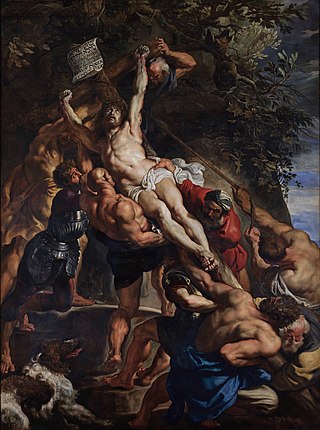
Flemish Baroque painting was a style of painting in the Southern Netherlands during Spanish control in the 16th and 17th centuries. The period roughly begins when the Dutch Republic was split from the Habsburg Spain regions to the south with the Spanish recapturing of Antwerp in 1585 and goes until about 1700, when Spanish Habsburg authority ended with the death of King Charles II. Antwerp, home to the prominent artists Peter Paul Rubens, Anthony van Dyck, and Jacob Jordaens, was the artistic nexus, while other notable cities include Brussels and Ghent.
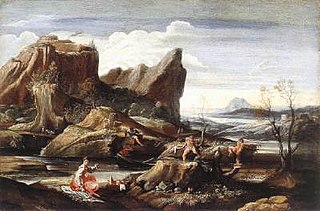
Pieter de Molijn was a Dutch Golden Age painter and engraver of English birth and Flemish descent.

Charles Emmanuel Biset or Karel Emmanuel Biset was a Flemish painter who had a peripatetic career working in various cities and countries including his hometown Mechelen, Paris, Annonay, Brussels, Antwerp and Breda. He worked in many genres including genre scenes of interiors with merry companies and gallery paintings, history painting, still life and portraiture.
The Royal Academy of Fine Arts of Ghent is an art school that is one of the oldest art schools in Belgium. It is now part of the Hogeschool Gent.

Jacob Grimmer was a Flemish landscape painter and draughtsman. His rural scenes and landscapes of views around Antwerp marked an important development in 16th century Flemish landscape painting away from the world landscape with its fantastic panoramas and whimsically-shaped gigantic rocks towards greater simplicity and authenticity. His work influenced the next generation of Flemish landscape painters. Grimmer was a capable colorist who was able to create harmonic landscapes by using realistic colours and atmospheric values effectively.

Peter Ykens, was a Flemish painter mainly known for his history paintings and portraits. He regularly collaborated with specialist still painters and landscape artists for whose works he provided the staffage.

Frans Boels was a Flemish painter and draftsman, who was active in the Dutch Republic in the latter part of his life. He is mainly known for his landscape paintings with Biblical or mythological scenes or hunting parties.
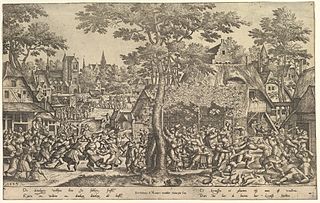
Pieter van der Borcht (I) or Peter van der Borcht (c. 1530–1608) was a Flemish Renaissance painter, draughtsman and etcher. He is regarded as one of the most gifted botanical painters of the 16th century. Pieter van der Borcht the Elder also introduced new themes such as the 'monkey scene' (also called 'singerie') into Northern art.

Hendrik Frans Schaefels or Henri François Schaefels, also known as Rik Schaefels, was a Belgian Romantic painter, draughtsman and engraver known for his seascapes, cityscapes, genre paintings, landscapes with figures and history paintings. He worked in the Romantic style popular in Belgium in the mid nineteenth century and was highly esteemed in Europe for his representations of historic naval battles.

Jan Michiel Ruyten or Jan Ruyten was a Belgian Romantic painter, draughtsman and engraver known for his genre paintings, cityscapes, landscapes with figures and history paintings. He was influenced by Dutch Romantic painting.

Franz Meerts or Frans Meerts was a Belgian painter and aquarellist known for his interior scenes, genre scenes, still lifes and landscapes. He was also active as an author, publisher and copyist.




















